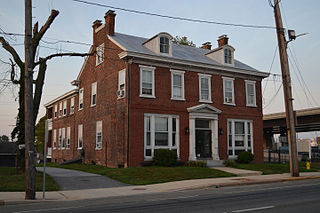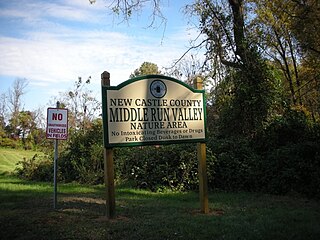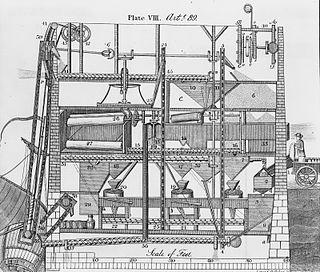
Newark is a small city in New Castle County, Delaware, United States. It is located 12 miles (19 km) west-southwest of Wilmington. According to the 2010 Census, the population of the city is 31,454. Newark is home to the University of Delaware.

Newport is a town in New Castle County, Delaware, United States. It is on the Christina River. It is best known for being the home of colonial inventor Oliver Evans. The population was 1,055 at the 2010 census. Four limited access highways, I-95, I-295, I-495, and Delaware Route 141 intersect within one mile (1.6 km) of the town.

Eddystone is a borough in Delaware County, Pennsylvania. The population was 2,410 at the 2010 census.

Brandywine Creek is a tributary of the Christina River in southeastern Pennsylvania and northern Delaware in the United States. The Lower Brandywine is 20.4 miles (32.8 km) long and is a designated Pennsylvania Scenic River with several tributary streams. The East Branch and West Branch of the creek originate within 2 miles (3 km) of each other on the slopes of Welsh Mountain in Honey Brook Township, Pennsylvania, about 20 miles (32 km) northwest of their confluence.

White Clay Creek is an 18.5-mile-long (29.8 km) tributary of the Christina River in southern Pennsylvania and northern Delaware in the United States. It is renowned for its scenic character and is largely federally protected.
Red Clay Creek is a 12.7-mile-long (20.4 km) tributary of White Clay Creek, running through southeastern Pennsylvania and northern Delaware in the United States. As of 2000, portions of the creek are under wildlife habitat protection.
There were several historic mills around the metro Atlanta area, for which many of its current-day roads are still named. Most of the mills date back to the 1820s and 1830s, and were built along the area's many streams. The locations of many of these mills are shown on a map of 1875 showing U. S. military operations around Atlanta in 1864. This map is now located in the U. S. Library of Congress but can be seen on the webpage linked here.
Mill Creek Hundred is an unincorporated subdivision of New Castle County, Delaware. Hundreds were once used as a basis for representation in the Delaware General Assembly, and while their names still appear on all real estate transactions, they presently have no meaningful use or purpose except as a geographical point of reference.

Ridley Creek State Park is a 2,606-acre (1,055 ha) Pennsylvania state park in Edgmont, Middletown, and Upper Providence Townships, Delaware County, Pennsylvania in the United States. The park, about 5 miles (8 km) north of the county seat of Media, offers many recreational activities, such as hiking, biking, fishing, and picnicking. Ridley Creek passes through the park. Highlights include a 5-mile (8 km) paved multi-use trail, a formal garden designed by the Olmsted Brothers, and Colonial Pennsylvania Plantation, which recreates daily life on a pre-Revolutionary farm. The park is adjacent to the John J. Tyler Arboretum. Ridley Creek State Park is just over 16 miles (26 km) from downtown, Philadelphia between Pennsylvania Route 352 and Pennsylvania Route 252 on Gradyville Road.

Ridley Creek is a tributary of the Delaware River in Chester and Delaware counties, Pennsylvania in the United States.
Hershey Run is a 2.9-mile-long (4.7 km) stream located in New Castle County, Delaware. It is a tributary of White Clay Creek.

White Clay Creek Preserve is a 3,050-acre (1,230 ha) Pennsylvania state park along the valley of White Clay Creek in London Britain Township in Chester County, Pennsylvania in the United States. The park was donated by the DuPont Company in 1984 for the purpose of "preserving the diverse and unique plant and animal species, and the rich cultural heritage of the area". Dupont also donated an additional 528 acres (214 ha) for the adjoining White Clay Creek State Park to the state of Delaware. White Clay Creek Preserve is 3 miles (4.8 km) north of Newark, Delaware on Pennsylvania Route 896.

White Clay Creek State Park is a Delaware state park along White Clay Creek on 3,647 acres (1,476 ha) in New Castle County, near Newark, Delaware in the United States. North of the park is Pennsylvania's White Clay Creek Preserve, and the two were originally operated as bi-state parks to jointly protect the creek, but now they operate separately. The White Clay Creek is federally protected as part of the National Park Service's National Wild and Scenic Rivers System. White Clay Creek State Park offers 37 miles (60 km) of nature and fitness trails which are open to hiking and mountain biking 365 days a year with access at a number of seasonal day-use fee parking lots. Fee season is in effect March 1 - November 30. Fees are $4 for in-state vehicle or $8 for out of state vehicles. Annual passes can be purchased at any DE State Park Office or online. The park also preserves a number of historic structures and operates a nature center. It is part of the Northeastern coastal forests ecoregion.

Delaware Route 72 (DE 72) is a state highway located in New Castle County, Delaware. The route runs from DE 9 near Delaware City north to DE 7 in Pike Creek. The highway runs through suburban areas of northern New Castle County, passing through the eastern part of Newark. DE 72 intersects U.S. Route 13 (US 13), DE 7, and DE 1 near Delaware City, DE 71 in Williamsburg, US 40 east of Glasgow, and DE 4, DE 2, and DE 273 in Newark. Parts of DE 72 were built as a state highway during the 1930s. By the 1940s, the route was designated between DE 2 in Newark and DE 7 in Pike Creek along Paper Mill Road. The route was extended south to DE 9 in the 1960s. In 1980, the alignment was shifted to the east through Newark to bypass an at-grade railroad crossing on Chapel Street.
The Pomeroy and Newark Railroad was a predecessor of the Pennsylvania Railroad in the U.S. states of Delaware and Pennsylvania. It connected Pomeroy, Pennsylvania to Newark, Delaware, and has mostly been abandoned.

Shellpot Creek is a tributary of the Delaware River in northeast New Castle County, Delaware. The stream rises between Grubb Road and Shipley Road, south of Naaman's Road at 39°49′19″N75°31′55″W in Brandywine Hundred and flows southeast for about six miles before discharging into the Delaware River at 39°44′05″N75°30′16″W near Edgemoor. Prior to 1938, the stream drained into the Brandywine Creek, but was subsequently redirected to the Delaware River.

Middle Run Valley Natural Area is a nature park owned and maintained by New Castle County, Delaware. The park, known also by its initials MRVNA, is located east of downtown Newark amidst residential neighborhoods and other park land. Establishment of MRVNA was begun in 1975; eventually the park reached its current 850 acres (3.4 km2) of forests, fields, creeks, and ponds. The most important of the creeks is Middle Run, which is a tributary of White Clay Creek, and flows mainly north to south through the park. The John C. Vansant House is located in the Middle Run Valley Natural Area.
Stanton is an unincorporated community in New Castle County, Delaware, United States, near the confluence of the Red Clay and White Clay Creeks. It is located in the southern end of Mill Creek Hundred.

The Poesten Kill is a 26.2-mile-long (42.2 km) creek in upstate New York located entirely in Rensselaer County, which flows westerly from its source at Dyken Pond in the town of Berlin to its mouth at the Hudson River in the city of Troy. It has been used historically as a source of water for local inhabitants and farmers and became even more important as a source of water power during the Industrial Revolution, during which many mills and factories sprung up along its banks.

Brandywine Village was an early center of U.S. industrialization located on the Brandywine River in what is now Wilmington, Delaware.














